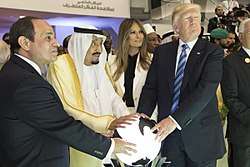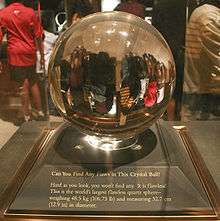Crystal ball
A crystal ball, also known as an orbuculum, is a crystal or glass ball and common fortune telling object.[lower-alpha 1] It is generally associated with the performance of clairvoyance and scrying in particular.
History
The earliest use of a crystal ball can be first attributed to the Celtic Druids who divined the future and omens with beryl balls.[1]
In the 1st century AD, Pliny the Elder describes use of crystal balls by soothsayers ("crystallum orbis", later written in Medieval Latin by scribes as orbuculum).[2] By the 5th century AD, scrying was widespread within the Roman Empire and was condemned by the early medieval Christian Church as heretical.[3]
Dr. John Dee was a noted British mathematician, astronomer, astrologer, geographer, and consultant to Queen Elizabeth I. He devoted much of his life to alchemy, divination, and Hermetic philosophy, of which the use of crystal balls was often included.[4]
Crystal gazing was a popular pastime in the Victorian era, and was claimed to work best when the Sun is at its northernmost declination. Immediately before the appearance of a vision, the ball was said to mist up from within.[3]
Art of scrying

The art or process of "seeing" is known as "scrying", whereby images are claimed to be seen in crystals, or other media such as water, and are interpreted as meaningful information. The "information" gleaned then is used to make important decisions in one's life (i.e. love, marriage, finances, travel, business, etc.).[5]
When the technique of scrying is used with crystals, or any transparent body, it is known as crystallomancy or crystal gazing.
In stage magic
Crystal balls are popular props used in mentalism acts by stage magicians. Such routines, in which the performer answers audience questions by means of various ruses, are known as crystal gazing acts. One of the most famous performers of the 20th century, Claude Alexander, was often billed as "Alexander the Crystal Seer".
Properties
A crystal ball is essentially a bi-convex spherical lens with a uniform radius of curvature, although without its edges and center material truncated as in a conventional lens construction. Thus the principles of optics may be applied to analyze its imaging characteristics.
As a lens, a transparent sphere of any material with refractive index greater than one bends rays of light to a focal point. An image is formed with significant coma, field curvature, and other optical aberrations inherent to spherical lenses. The refractive index of typical materials used for crystal balls (quartz: 1.46, window glass: 1.52), produces a central focal point just outside the surface of the sphere, on the side diametrically opposite to where the rays entered.
For materials with refractive index greater than 2, the focus will be located inside the sphere. In this case the image is not directly accessible, while the closest accessible point is on its surface directly opposite the source of light. However, few materials have a refractive index this high. For a refractive index of 2, the image forms on the surface of the sphere, and the image may be viewed on an translucent object or diffusing coating on the imaging side of the sphere.
Since a crystal ball has no edges like a conventional lens, the image-forming properties are omnidirectional (independent of the direction being imaged). This effect is exploited in the Campbell–Stokes recorder, a scientific instrument which records the brightness of sunlight by burning the surface of a paper card bent around the sphere. The device, itself fixed, records the apparent motion and intensity of the sun across the sky, burning an image of the sun's motion across the card.
The omnidirectional burning glass effect can occur with a crystal ball that is brought into full sunlight. The image of the sun formed by a large crystal ball will burn a hand that is holding it, and can ignite dark-coloured flammable material placed near it.[6]
Ball lenses such as are used to couple fiber optics are identical to crystal balls, but in tiny form, commonly 1mm to 10mm in diameter.
Famous crystal balls in history
A crystal ball lies in the Sceptre of Scotland that is said to have been originally possessed by pagan druids.[1]

Philadelphia's University of Pennsylvania Museum of Archaeology and Anthropology (also called Penn Museum for short) displays the third largest crystal ball[7] as the central object in its Chinese Rotunda. Weighing 49 pounds, the sphere is made of quartz crystal from Burma and was shaped through years of constant rotation in a semi-cylindrical container filled with emery, garnet powder, and water. The ornamental treasure was purportedly made for the Empress Dowager Cixi (1835-1908) during the Qing dynasty in the 19th century, but no evidence as to its actual origins exists. In 1988, the crystal ball and an ancient Egyptian statuette[8] which depicted the god Osiris were stolen from the Penn Museum but were recovered three years later with no damage done to either object.[9]

There's an audio game built into the Google Assistant on which tells the player to "Ask a Yes or No Question". The voice starts with an intro that says this line in a dramatic voice: "Come closer. Closer. Closer. Ok Stop. Close your eyes and quiet your mind. The Crystal Ball shall reveal the truth. Now ask a Yes or No Question." Then after the user asks a question, the voice responds with "The all knowing Crystal Ball says." and then gives a random answer. Also, if you ask it to play the Magic 8-ball the voice will say "Sorry, I don't have one of those. Instead I have a Crystal Ball." and opens the Crystal Ball game. The game also mentions about velvet curtains too.[10]
See also
Notes
- ↑ Sometimes further referred to as a shew stone (or show stone – "shew" is an archaic spelling of "show").
References
- 1 2 Sibyl Ferguson (30 June 2005). Crystal Ball: Stones, Amulets, And Talismans For Power, Protection, and Prophecy. Weiser Books. pp. 59–60, 29. ISBN 978-1-57863-348-7.
- ↑ Pliny the Elder (1831). Caii Plinii Secundi Historiæ naturalis libri xxxvii, cum selectis comm. J. Harduini ac recentiorum interpretum novisque adnotationibus. p. 579. Retrieved 7 November 2015. (in Latin)
- 1 2 "Crystal gazing". Encyclopædia Britannica. Retrieved 6 November 2015.
- ↑ John Dee's Crystal Ball
- ↑ Chauran, Alexandra. Crystal Ball Reading for Beginners: A Down To Earth Guide. Woodbury, Minnesota: Llewellyn Publications, 2011.
- ↑ Associated Press (29 January 2004). "Crystal Ball Starts Fire at Okla. Home". The Washington Post. Retrieved 22 December 2012.
- ↑ "Crystal Sphere". University of Pennsylvania Museum of Archaeology and Anthropology. Retrieved 21 September 2014.
- ↑ "Statue". University of Pennsylvania Museum of Archaeology and Anthropology. Retrieved 21 September 2014.
- ↑ "Penn Museum Crystal Ball, Statue Stolen Guard Ignored Burglar Alarms". Philly.com. Retrieved 21 September 2014.
- ↑ Ravenscraft, Eric. "The Best Games and Easter Eggs on Google Assistant". How-To Geek. Missing or empty
|url=(help);|access-date=requires|url=(help)
Further reading
- Andrew Lang, Crystal visions, savage and civilised, The Making of Religion, Chapter V, Longmans, Green, and C°, London, New York and Bombay, 1900, pp. 83–104.
- A Translation of Grimm's Fairy Tale No. 197 The Crystal Ball
- A Translation of Grimm's Saga No. 119 Crystal Ball Gazing
External links

